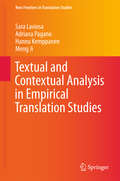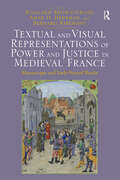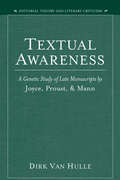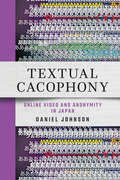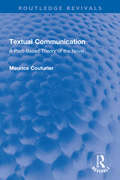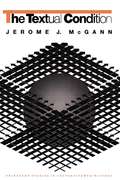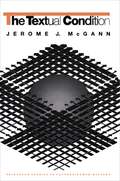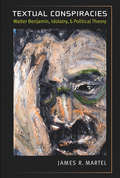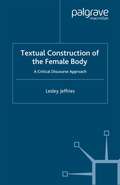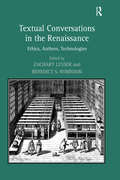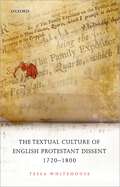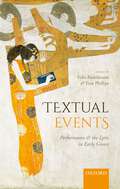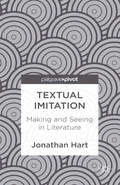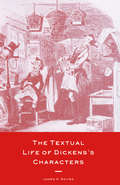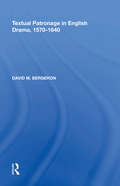- Table View
- List View
Textual and Contextual Analysis in Empirical Translation Studies (New Frontiers in Translation Studies)
by Sara Laviosa Adriana Pagano Hannu Kemppanen Meng JiThis book presents the state-of-art research in ETS by illustrating useful corpus methodologies in the study of important translational genres such as political texts, literature and media translations. Empirical Translation Studies (ETS) represents one of the most exciting fields of research. It gives emphasis and priority to the exploration and identification of new textual and linguistic patterns in large amounts of translation data gathered in the form of translation data bases. A distinct feature of current ETS is the testing and development of useful quantitative methods in the study of translational corpora. In this book, Hannu Kemppanen explores the distribution of ideologically loaded keywords in early Finnish translation of Russian political genres which yielded insights into the complex political relation between Finland and Russia in the post-Soviet era. Adriana Pagano uses multivariate analysis in the study of a large-scale corpus of Brazilian fiction translations produced between 1930s-1950s which is known as the golden age of Latin American translation. The statistical analysis detected a number of translation strategies in Brazilian Portuguese fictional translations which point to deliberate efforts made by translators to re-frame original English texts within the Brazilian social and political context in the first three decades under investigation. Meng Ji uses exploratory statistical techniques in the study of recent Chinese media translation by focusing three important media genres, i.e. reportage, editorial and review. The statistical analysis effectively detected important variations among three news genres which are analysed in light of the social and communicative functions of these news genres in informing and mobilising the audience in specific periods of time in Mainland China.
Textual and Visual Representations of Power and Justice in Medieval France: Manuscripts and Early Printed Books
by Rosalind Brown-Grant Anne D. Hedeman Bernard RibémontThoroughly interdisciplinary in approach, this volume examines how concepts such as the exercising of power, the distribution of justice, and transgression against the law were treated in both textual and pictorial terms in works produced and circulated in medieval French manuscripts and early printed books. Analysing texts ranging from romances, political allegories, chivalric biographies, and catalogues of famous men and women, through saints’ lives, mystery plays and Books of Hours, to works of Roman, canon and customary law, these studies offer new insights into the diverse ways in which the language and imagery of politics and justice permeated French culture, particularly in the later Middle Ages. Organized around three closely related themes - the prince as a just ruler, the figure of the judge, and the role of the queen in relation to matters of justice - the issues addressed in these studies, such as what constitutes a just war, what treatment should be meted out to prisoners, what personal qualities are needed for the role of lawgiver, and what limits are placed on women’s participation in judicial processes, are ones that are still the subject of debate today. What the contributors show above all is the degree of political engagement on the part of writers and artists responsible for cultural production in this period. With their textual strategies of exemplification, allegorization, and satirical deprecation, and their visual strategies of hierarchical ordering, spatial organization and symbolic allusion, these figures aimed to show that the pen and paintbrush could aspire to being as mighty as the sword wielded by Lady Justice herself.
Textual and Visual Representations of Power and Justice in Medieval France: Manuscripts and Early Printed Books
by Rosalind Brown-Grant Anne D. Hedeman Bernard RibémontThoroughly interdisciplinary in approach, this volume examines how concepts such as the exercising of power, the distribution of justice, and transgression against the law were treated in both textual and pictorial terms in works produced and circulated in medieval French manuscripts and early printed books. Analysing texts ranging from romances, political allegories, chivalric biographies, and catalogues of famous men and women, through saints’ lives, mystery plays and Books of Hours, to works of Roman, canon and customary law, these studies offer new insights into the diverse ways in which the language and imagery of politics and justice permeated French culture, particularly in the later Middle Ages. Organized around three closely related themes - the prince as a just ruler, the figure of the judge, and the role of the queen in relation to matters of justice - the issues addressed in these studies, such as what constitutes a just war, what treatment should be meted out to prisoners, what personal qualities are needed for the role of lawgiver, and what limits are placed on women’s participation in judicial processes, are ones that are still the subject of debate today. What the contributors show above all is the degree of political engagement on the part of writers and artists responsible for cultural production in this period. With their textual strategies of exemplification, allegorization, and satirical deprecation, and their visual strategies of hierarchical ordering, spatial organization and symbolic allusion, these figures aimed to show that the pen and paintbrush could aspire to being as mighty as the sword wielded by Lady Justice herself.
Textual Awareness: A Genetic Study of Late Manuscripts by Joyce, Proust, and Mann (Editorial Theory And Literary Criticism)
by Dirk Van HulleAware of the act of writing as a temporal process, many modernist authors preserved numerous manuscripts of their works, which themselves thematized time. Textual Awareness analyzes the writing processes in James Joyce's Finnegans Wake, Marcel Proust's À la recherche du temps perdu, and Thomas Mann's Doktor Faustus and relates these to Anglo-American, French, and German theories of text. By relating theory to practice, this comparative study reveals the links between literary and textual criticism. A key issue in both textual criticism and the so-called crisis of the novel is the tension between the finished and the unfinished. After a theoretical examination of the relationship between genetic and textual criticism, Dirk Van Hulle uses the three case studies to show how?at each stage in the writing process?the text still had the potential of becoming something entirely different; how and why these geneses proceeded the way they did; how Joyce, Proust, and Mann allowed contingencies to shape their work; how these authors recycled the words of their critics in order to inoculate their works against them; how they shaped an intertextual dimension through the processing of source texts and reading notes; and how text continually generated more text. Van Hulle's exploration of process sheds new light on the remarkable fact that so many modernist authors protected their manuscripts, implying both the authors' urge to grasp everything and their awareness of the dangers of their encyclopedic projects. Textual Awareness offers new insights into the artificiality of the artifact?the novel?that are relevant to the study of literary modernism in general and the study of James Joyce, Marcel Proust, and Thomas Mann in particular. Dirk Van Hulle is Assistant Professor of English and German Literature, University of Antwerp.
Textual Cacophony: Online Video and Anonymity in Japan
by Daniel JohnsonTextual Cacophony explores the behaviors and routines of communication within anonymous internet culture in Japan. Focusing on the video sharing website Niconico, social media aggregation sites, and the notorious 2channel message board, Daniel Johnson uncovers these sites' complex cultures of writing that obscure meaning through playful and opaque forms of deviant script and overwhelming waves of text. Those practices conflate language with images, meaning with play, and confound individual representation with aggregate forms of social identity. Johnson argues that online media cultures in and around Japan are entwined with a cultural logic and visual syntax of cacophony that expresses ambivalence toward representation, media form, and distinct experiences of time. This aesthetic of cacophony provides an alternative way of expressing social identity and belonging, with an unmarked sense of anonymity providing a counter-form to the dissolving institutions and relationships of neoliberal Japan. Textual Cacophony investigates what it means and feels like to participate in this influential online culture.
Textual Communication: A Print-Based Theory of the Novel (Routledge Revivals)
by Maurice CouturierFirst published in 1991, Textual Communication examines the character and development of the novel from Richardson to Nabokov in relation to the printing and publishing industry. The book blends literary theory with a historical analysis of communication, carrying the debate on the novel beyond the pioneering work of Booth and Genette, while responding to and taking issue with the writings of Foucault, Baudrillard, McLuhan, and Barthes. It analyses the structures of the industry which manufactured and marketed novels to show how novelists solved the communication problems that they faced in the eighteenth, nineteenth, and twentieth centuries. It also pinpoints critical moments in the history of the novel when new narrative strategies appeared, and places them in the context of the communication environment in which the texts were produced. Using Lacan’s theory of the divided subject, the book defines textual communication as a form of interaction in which two divided subjects, the author and the reader, try to communicate with each other under or against the law of the book market, censorship, literary conventions, and language.
Textual Communication: A Print-Based Theory of the Novel (Routledge Revivals)
by Maurice CouturierFirst published in 1991, Textual Communication examines the character and development of the novel from Richardson to Nabokov in relation to the printing and publishing industry. The book blends literary theory with a historical analysis of communication, carrying the debate on the novel beyond the pioneering work of Booth and Genette, while responding to and taking issue with the writings of Foucault, Baudrillard, McLuhan, and Barthes. It analyses the structures of the industry which manufactured and marketed novels to show how novelists solved the communication problems that they faced in the eighteenth, nineteenth, and twentieth centuries. It also pinpoints critical moments in the history of the novel when new narrative strategies appeared, and places them in the context of the communication environment in which the texts were produced. Using Lacan’s theory of the divided subject, the book defines textual communication as a form of interaction in which two divided subjects, the author and the reader, try to communicate with each other under or against the law of the book market, censorship, literary conventions, and language.
The Textual Condition
by Jerome J. McgannOver the past decade literary critic and editor Jerome McGann has developed a theory of textuality based in writing and production rather than in reading and interpretation. These new essays extend his investigations of the instability of the physical text. McGann shows how every text enters the world under socio-historical conditions that set the stage for a ceaseless process of textual development and mutation. Arguing that textuality is a matter of inscription and articulation, he explores texts as material and social phenomena, as particular kinds of acts. McGann links his study to contextual and institutional studies of literary works as they are generated over time by authors, editors, typographers, book designers, marketing planners, and other publishing agents. This enables him to examine issues of textual stability and instability in the arenas of textual production and reproduction. Drawing on literary examples from the past two centuries--including works by Byron, Blake, Morris, Yeats, Joyce, and especially Pound--McGann applies his theory to key problems facing anyone who studies texts and textuality.
The Textual Condition (Princeton Studies in Culture/Power/History #7)
by Jerome J. McGannOver the past decade literary critic and editor Jerome McGann has developed a theory of textuality based in writing and production rather than in reading and interpretation. These new essays extend his investigations of the instability of the physical text. McGann shows how every text enters the world under socio-historical conditions that set the stage for a ceaseless process of textual development and mutation. Arguing that textuality is a matter of inscription and articulation, he explores texts as material and social phenomena, as particular kinds of acts. McGann links his study to contextual and institutional studies of literary works as they are generated over time by authors, editors, typographers, book designers, marketing planners, and other publishing agents. This enables him to examine issues of textual stability and instability in the arenas of textual production and reproduction. Drawing on literary examples from the past two centuries--including works by Byron, Blake, Morris, Yeats, Joyce, and especially Pound--McGann applies his theory to key problems facing anyone who studies texts and textuality.
Textual Conspiracies: Walter Benjamin, Idolatry, and Political Theory
by James Martel“This is a sophisticated and fascinating argument written in a very enjoyably entertaining style. It is hard for me to see how readers initially interested in these texts will not be ‘swept off their feet’ by the core assertions of this author, and the devastatingly comprehensive way in which he demonstrates those arguments.” —Brent Steele, University of Kansas In Textual Conspiracies, James R. Martel applies the literary, theological, and philosophical insights of Walter Benjamin to the question of politics and the predicament of the contemporary left. Through the lens of Benjamin’s theories, as influenced by Kafka, of the fetishization of political symbols and signs, Martel looks at the ways in which various political and literary texts “speak” to each other across the gulf of time and space, thereby creating a “textual conspiracy” that destabilizes grand narratives of power and authority and makes the narratives of alternative political communities more apparent. However, in keeping with Benjamin’s insistence that even he is complicit with the fetishism that he battles, Martel decentralizes Benjamin’s position as the key theorist for this conspiracy and contextualizes Benjamin in what he calls a “constellation” of pairs of thinkers and writers throughout history, including Alexis de Tocqueville and Edgar Allen Poe, Hannah Arendt and Federico García Lorca, and Frantz Fanon and Assia Djebar.
Textual Construction of the Female Body: A Critical Discourse Approach
by L. JeffriesThis volume takes a critical discourse approach to the ways women's magazines contribute to the social construction of particular kinds of female body - as ideal, beautiful, ugly, overweight or engineered. Looking at the language used, it provides an insight into the experience of the female reader, and the likely impact upon her self-image.
Textual Conversations in the Renaissance: Ethics, Authors, Technologies
by Benedict S. Robinson'Conversation is the beginning and end of knowledge', wrote Stephano Guazzo in his Civil Conversation. Like Guazzo's, this is a book dedicated to the Renaissance concept of conversation, a concept that functioned simultaneously as a privileged literary and rhetorical form (the dialogue), an intellectual and artistic program (the humanists' interactions with ancient texts), and a political possibility (the king's council, or the republican concept of mixed government). In its varieties of knowledge production, the Renaissance was centrally concerned with debate and dialogue, not only among scholars, but also, and perhaps more importantly, among and with texts. Renaissance reading practices were active and engaged: such conversations with texts were meant to prepare the mind for political and civic life, and the political itself was conceived as fundamentally conversational. The humanist idea of conversation thus theorized the relationships among literature, politics, and history; it was one of the first modern attempts to locate cultural production within a specific historical and political context. The essays in this collection investigate the varied ways in which the Renaissance incorporated textual conversation and dialogue into its literary, political, juridical, religious, and social practices. They focus on the importance of conversation to early modern understandings of ethics; on literary history itself as an ongoing authorial conversation; and on the material and textual technologies that enabled early modern conversations.
Textual Conversations in the Renaissance: Ethics, Authors, Technologies
by Benedict S. Robinson'Conversation is the beginning and end of knowledge', wrote Stephano Guazzo in his Civil Conversation. Like Guazzo's, this is a book dedicated to the Renaissance concept of conversation, a concept that functioned simultaneously as a privileged literary and rhetorical form (the dialogue), an intellectual and artistic program (the humanists' interactions with ancient texts), and a political possibility (the king's council, or the republican concept of mixed government). In its varieties of knowledge production, the Renaissance was centrally concerned with debate and dialogue, not only among scholars, but also, and perhaps more importantly, among and with texts. Renaissance reading practices were active and engaged: such conversations with texts were meant to prepare the mind for political and civic life, and the political itself was conceived as fundamentally conversational. The humanist idea of conversation thus theorized the relationships among literature, politics, and history; it was one of the first modern attempts to locate cultural production within a specific historical and political context. The essays in this collection investigate the varied ways in which the Renaissance incorporated textual conversation and dialogue into its literary, political, juridical, religious, and social practices. They focus on the importance of conversation to early modern understandings of ethics; on literary history itself as an ongoing authorial conversation; and on the material and textual technologies that enabled early modern conversations.
The Textual Culture of English Protestant Dissent 1720-1800
by Tessa WhitehouseReligious dissenters and their literary and social heritage are the principal subjects of this book. At its heart is a group of English men whose activities were local, transcontinental and circum-Atlantic. Drawing on letters, lecture notes, manuscript accounts of academies, and a range of printed texts and paratexts The Textual Culture of English Protestant Dissent 1720-1800 explores the connections between dissent, education, and publishing in the eighteenth century. By considering Isaac Watts and Philip Doddridge in relation to their mentors, students, friends, and readers it emphasizes the importance they and their associates attached to personal relationships in their private interactions and in print. It argues that this contributed to a distinctive literary style as well as particular modes of textual production for moderate, orthodox dissenters which reached beyond their own community to address and influence global discourses about education, enlightenment, and history. The book's focus on 'textual culture' foregrounds relationships between forms as well as considering texts as they existed in one form or another. In examining textual culture, this book emphasises adaptation, transformation, fluidity and communality: it approaches the human relationships that make texts (including friendships, reading communities, intellectual exchange and business arrangements) with as much care as the content of the texts themselves. The book demonstrates that models of family and social authorship among Romantic-era dissenters advanced by Michelle Levy, Daniel White and Felicity James were rooted in the domestic culture at earlier academies and in the example of members of the Watts-Doddridge circle.
Textual Emotion Classification Using Deep Broad Learning (Socio-Affective Computing #11)
by Sancheng Peng Lihong CaoIn this book, the authors systematically and comprehensively discuss textual emotion classification by using deep broad learning. Since broad learning possesses certain advantages such as simple network structure, short training time and strong generalization ability, it is a new and promising framework for textual emotion classification in artificial intelligence. As a result, how to combine deep and broad learning has become a new trend of textual emotion classification, a booming topic in both academia and industry. For a better understanding, both quantitative and qualitative results are present in figures, tables, or other suitable formats to give the readers the broad picture of this topic along with unique insights of common sense and technical details, and to pave a solid ground for their forthcoming research or industry applications. In a progressive manner, the readers will gain exclusive knowledge in textual emotion classification using deep broad learning and be inspired to further investigate this underexplored domain. With no other similar book existing in the literature, the authors aim to make the book self-contained for newcomers, only a few prerequisites being expected from the readers. The book is meant as a reference for senior undergraduates, postgraduates, scientists and researchers interested to have a quick idea of the foundations and research progress of security and privacy in federated learning, and it can equally well be used as a textbook by lecturers, tutors, and undergraduates.
Textual Events: Performance and the Lyric in Early Greece
by Tom Phillips Felix BudelmannRecent decades have seen a major expansion in our understanding of how early Greek lyric functioned in its social, political, and ritual contexts, and the fundamental role song played in the day-to-day lives of communities, groups, and individuals has been the object of intense study. This volume places its focus elsewhere, and attempts to illuminate poetic effects that cannot be captured in functional terms alone. Employing a range of interpretative methods, it explores the idea of lyric performances as 'textual events'. Some chapters investigate the pragmatic relationship between real performance contexts and imaginative settings, while others consider how lyric poems position themselves in relation to earlier texts and textual traditions, or discuss the distinctive encounters lyric poems create between listeners, authors, and performers. Individual lyric texts and authors, such as Sappho, Alcaeus, and Pindar, are analysed in detail, alongside treatments of the relationship between lyric and the Homeric Hymns. Building on the renewed concern with the aesthetic in the study of Greek lyric and beyond, Textual Events aims to re-examine the relationship between the poems' formal features and their historical contexts. Lyric poems are a type of socio-political discourse, but they are also objects of attention in themselves. They enable reflection on social and ritual practices as much as they are embedded within them. As well as expressing cultural norms, lyric challenges listeners to think about and experience the world afresh.
Textual Events: Performance and the Lyric in Early Greece
Recent decades have seen a major expansion in our understanding of how early Greek lyric functioned in its social, political, and ritual contexts, and the fundamental role song played in the day-to-day lives of communities, groups, and individuals has been the object of intense study. This volume places its focus elsewhere, and attempts to illuminate poetic effects that cannot be captured in functional terms alone. Employing a range of interpretative methods, it explores the idea of lyric performances as 'textual events'. Some chapters investigate the pragmatic relationship between real performance contexts and imaginative settings, while others consider how lyric poems position themselves in relation to earlier texts and textual traditions, or discuss the distinctive encounters lyric poems create between listeners, authors, and performers. Individual lyric texts and authors, such as Sappho, Alcaeus, and Pindar, are analysed in detail, alongside treatments of the relationship between lyric and the Homeric Hymns. Building on the renewed concern with the aesthetic in the study of Greek lyric and beyond, Textual Events aims to re-examine the relationship between the poems' formal features and their historical contexts. Lyric poems are a type of socio-political discourse, but they are also objects of attention in themselves. They enable reflection on social and ritual practices as much as they are embedded within them. As well as expressing cultural norms, lyric challenges listeners to think about and experience the world afresh.
Textual Imitation: Making And Seeing In Literature
by J. HartTextual Imitation offers a new critique of the space between fiction and truth, poetry and philosophy. In a nimble, yet startlingly wide-ranging argument, esteemed scholar Jonathan Hart argues that recognition and misrecognition are the keys to understanding texts and contexts from the Old World to the New World.
The Textual Life of Airports: Reading the Culture of Flight
by Christopher SchabergThis is a book about airport stories. It is about common narratives of airports that circulate in everyday life, and about the secret stories of airports-the strange or hidden narratives that do not always fit into standard ideas of these in-between places. Tales of near disaster, endless delays, dramatic weather shifts, a lost bag that suddenly appears-such stories are familiar accounts of a place that seems to thrive on and recycle its own mythologies. The Textual Life of Airports shows how airports demand to be read. Working at the intersection of literary studies and cultural theory, Schaberg tracks airport stories in American literature, as well as in a range of visual texts (film, airport art, magazine illustrations). It accounts for how airports appear in literature throughout the twentieth-century, while also examining the influx of airport figures in markedly post-9/11 literature and culture. These literary and cultural representations work together to form "the textual life of airports."
The Textual Life of Airports: Reading the Culture of Flight
by Christopher SchabergThis is a book about airport stories. It is about common narratives of airports that circulate in everyday life, and about the secret stories of airports-the strange or hidden narratives that do not always fit into standard ideas of these in-between places. Tales of near disaster, endless delays, dramatic weather shifts, a lost bag that suddenly appears-such stories are familiar accounts of a place that seems to thrive on and recycle its own mythologies. The Textual Life of Airports shows how airports demand to be read. Working at the intersection of literary studies and cultural theory, Schaberg tracks airport stories in American literature, as well as in a range of visual texts (film, airport art, magazine illustrations). It accounts for how airports appear in literature throughout the twentieth-century, while also examining the influx of airport figures in markedly post-9/11 literature and culture. These literary and cultural representations work together to form "the textual life of airports."
The Textual Life of Dickens's Characters
by James A. DaviesBy focusing on selected characters and characterizations from all stages of Dickens' literary career, both fiction and non-fiction, this book looks at the thematic significance of the modern distinction between story and text.
Textual Magic: Charms and Written Amulets in Medieval England
by Katherine Storm HindleyAn expansive consideration of charms as a deeply integrated aspect of the English Middle Ages. Katherine Storm Hindley explores words at their most powerful: words that people expected would physically change the world. Medieval Europeans often resorted to the use of spoken or written charms to ensure health or fend off danger. Hindley draws on an unprecedented archive of more than a thousand such charms from medieval England—more than twice the number gathered, transcribed, and edited in previous studies and including many texts still unknown to specialists on this topic. Focusing on charms from 1100 to 1350 CE as well as previously unstudied texts in Latin, French, and English, Hindley addresses important questions of how people thought about language, belief, and power. She describes seven hundred years of dynamic, shifting cultural landscapes, where multiple languages, alphabets, and modes of transmission gained and lost their protective and healing power. Where previous scholarship has bemoaned a lack of continuity in the English charms, Hindley finds surprising links between languages and eras, all without losing sight of the extraordinary variety of the medieval charm tradition: a continuous, deeply rooted part of the English Middle Ages.
Textual Magic: Charms and Written Amulets in Medieval England
by Katherine Storm HindleyAn expansive consideration of charms as a deeply integrated aspect of the English Middle Ages. Katherine Storm Hindley explores words at their most powerful: words that people expected would physically change the world. Medieval Europeans often resorted to the use of spoken or written charms to ensure health or fend off danger. Hindley draws on an unprecedented archive of more than a thousand such charms from medieval England—more than twice the number gathered, transcribed, and edited in previous studies and including many texts still unknown to specialists on this topic. Focusing on charms from 1100 to 1350 CE as well as previously unstudied texts in Latin, French, and English, Hindley addresses important questions of how people thought about language, belief, and power. She describes seven hundred years of dynamic, shifting cultural landscapes, where multiple languages, alphabets, and modes of transmission gained and lost their protective and healing power. Where previous scholarship has bemoaned a lack of continuity in the English charms, Hindley finds surprising links between languages and eras, all without losing sight of the extraordinary variety of the medieval charm tradition: a continuous, deeply rooted part of the English Middle Ages.
Textual Metonymy: A Semiotic Approach
by A. Al-SharafiTextual Metonymy employs a theoretical framework combining rhetoric, figurative theory and textlinguistics. In the process, a very full historical account of treatments of metonymy from classical traditions up to the present time is given and critiqued. The author proposes a semiotic approach to the treatment of metonymy, on the basis of which a textual model of metonymy as a process of representation is developed to account for text cohesion and text coherence.
Textual Patronage in English Drama, 1570-1640
by David M. BergeronThrough an investigation of the dedications and addresses from various printed plays of the English Renaissance, the author recuperates the richness of these prefaces and connects them to the practice of patronage. The prefatory matter discussed ranges from the printer John Day's address to readers (the first of its kind) in the 1570 edition of Gorboduc to Richard Brome's dedication to William Seymour and address to readers in his 1640 play, Antipodes. The study includes discussion of prefaces in plays by Shakespeare's contemporaries as well as Shakespeare himself, among them Marston, Jonson, and Heywood. The author uses these prefaces to show that English playwrights, printers and publishers looked in two directions, toward aristocrats and toward a reading public, in order to secure status for and dissemination of dramatic texts. The author points out that dedications and addresses to readers constitute obvious signs that printers, publishers and playwrights in the period increasingly saw these dramatic texts as occupying a rightful place in the humanistic and commercial endeavor of book production.
